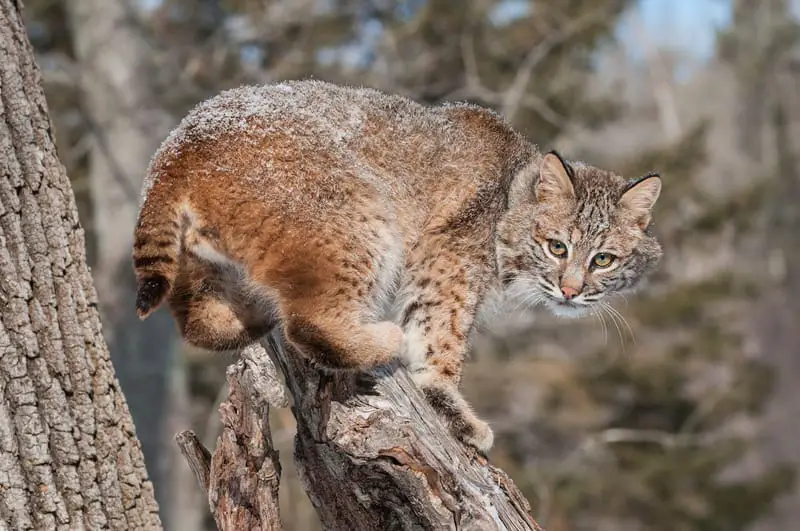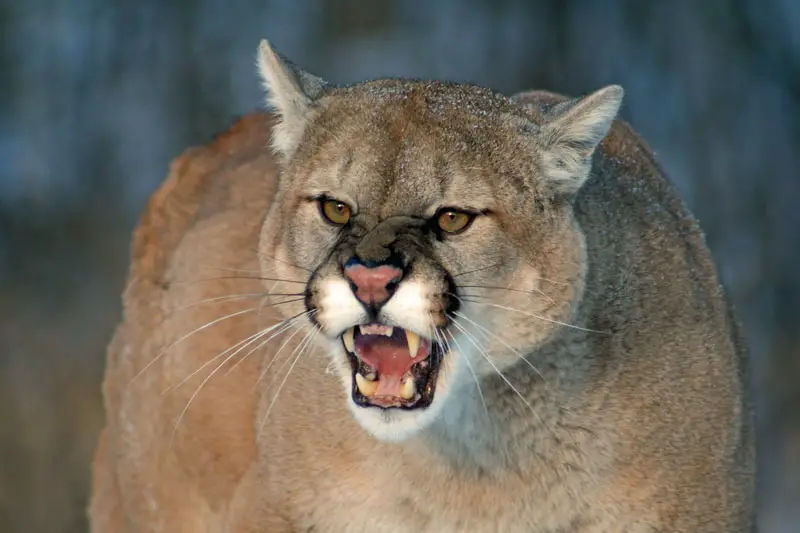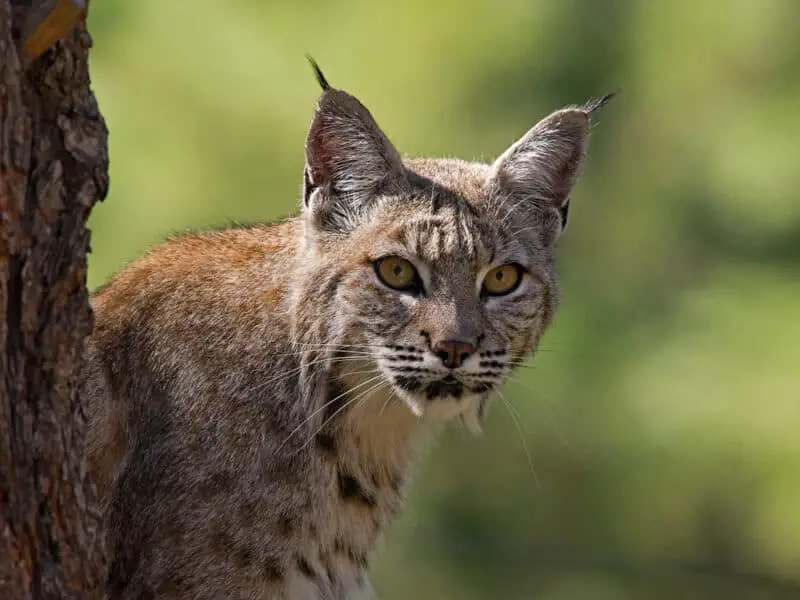In the state of Illinois, the only wild cat species with a breeding population is the bobcat. Mountain lions are also native to the state. What’s more, there is an occasional cougar sighting in Illinois. However, these large feline predators have been extirpated from the state since the nineteenth century. Let’s talk a little bit about both of these wild cats.
Bobcats in Illinois (Lynx rufus)
The American bobcat, which is also known as the red lynx, is a North American wild cat. Biologists believe that both the bobcat and the Canada lynx are descendants of the Eurasian lynx whose ancestors crossed into North America via the Bearing Sea land bridge.
Bobcats reside only in North America. Their range begins in Canada. Central British Columbia is the furthest north that bobcats live. Their range extends south through the United States and down into central Mexico. They are the most common wildcats in North America.
According to the Illinois Bobcat Foundation website, throughout the 19th and early 20th centuries, bobcats were considered to be a varmint and a danger to livestock. Consequently, state and local governments paid bounties on them even though their pelts were worth very little.
Then, in the 1970s, large spotted cats became protected by the United States endangered species act and the Convention on International Trade in Endangered Species. This caused the value of the bobcat’s spotted pelts to increase sharply.
This played a part in the bobcat’s near extinction in Illinois.
For a time, bobcats were protected on the state’s threatened species list. Due to conservation efforts, their population began to rebound, though, and this designation was removed in 1999.
In 2016, the Illinois State Legislature allowed the first bobcat hunting and trapping season in the state over 40 years.
The Illinois Department of Natural Resources estimates that the bobcat population within the prairie state is around 5000.
Bobcat sightings are on the rise, and currently, the state has a healthy population of them. Although bobcats live throughout Illinois, most of these live in the southern third of the state.
Bobcats live in a variety of terrain. Look for them in broken habitat types that might include riparian woodland, dense forests, ravines, rocky ledges and/or outcroppings, and field borders.
The mottled black spots in the pattern of their fur gives them excellent camouflage to live undetected in these environments.
Bobcats do not hibernate. They are active throughout the year. However, they’re rarely seen since they’re predominantly nocturnal or crepuscular animals. See
Bobcats are solitary animals with the exceptions of during mating season or when a female is raising young. They are territorial and live in home ranges that they patrol and scent mark with urine and feces.
The size of their home ranges varies with the geography and the availability of prey. However, in western Illinois, male bobcat home ranges average 46 square miles while female bobcat home ranges average 8 miles. See
It’s also important to note that male and female bobcat home ranges sometimes overlap.

What do bobcats look like?
A bobcat is much smaller than a mountain lion and slightly smaller than a Canada lynx. An average bobcat is about twice the size of a house cat.
An adult bobcat is 2 to 3 feet long and weighs about 15 to 35 pounds. A female bobcat is quite a bit smaller than a male.
These animals have a “bobbed,” short tail with dark bands on their upper surface. Their tail also has a black tip on its upper surface but not the back. They generally have reddish-brown coats that can also trend to gray, with mottled dark spots that range from black to dark brown on their bodies. Additionally, they have dark stripes on their inner forelegs.
From a side view, you will notice that a bobcat is slightly higher at the rump than at the shoulders. Bobcats and lynx have long hind legs in proportion to their forelegs.
Bobcats have black-tufted ears. In other words, they have tufts of hair that poke up above their ears that are black at the tips. They do have shorter ear tufts than their close relative, the Canada lynx.
The backs of their ears, below the black tips, are black. In the center of the black of each ear, they have a single white spot. This gives the impression of a false eye on the back of each ear.
They also have a whiskered face that seems broader due to the ruff of fur on their cheeks and their whiskers. Their eyes are yellow with round black pupils.
Bobcats aren’t adapted for deep snow.
Compared to Canada lynx, which thrive in deep snow country, bobcats struggle more in the snow due to the fact that they cannot walk on top of it as lynx can. A lynx’s large paws function like snowshoes keeping it on the snow’s surface. On the other hand, compared to lynx, bobcats have small feet that tend to sink into the snow. If the snow is too deep and powdery, it reduces their mobility along with their ability to catch prey.
This is why the bobcat range dies out in southern Canada; from there on north, Canada lynx are more prevalent and bobcats less so.
Bobcats are also unable to live at higher elevations as lynx do in the winter. In the winter, lynx are able to stay in the high country to hunt their preferred prey, snowshoe hares.

What do bobcats eat?
Despite their comparatively small size, bobcats are aggressive, tough predators. At times, particularly during the winter, they prey on large mammals that are much larger than they are, such as white-tailed deer. However, deer are not their go-to prey. They feed on a variety of wildlife, but studies done on Iowa bobcats showed that 95 percent of their diet consists of small prey animals such as rabbits, mice, voles, and squirrels. They are opportunistic feeders and might also feed on such animals as beavers, muskrats, porcupines, birds, reptiles, insects, and carrion. When they take up residence close to a residential area, their menu might occasionally also include small agricultural animals and house pets.
Interestingly, they even prey on venomous snakes even though they are not immune to the venom. They accomplish this by using their quickness to pin the snake’s head down with a paw, after which they dispatch the snake with a quick bite to its spine behind the head.
The list of venomous snakes in Illinois includes the following: See
- Western cottonmouth (Agkistrodon piscivorus leucostoma)
- Eastern massasauga (Sistrurus catenatus catenatus)
- Timber Rattlesnake (Crotalus horridus
- Southern Copperhead (Agkistrodon contortrix)
- Northern Copperhead (Agkistrodon contortrix)
What eats bobcats?
In Illinois, coyotes, domestic dogs, great horned owls, and foxes may occasionally kill young bobcats. Other than that, these felines have no real predators.
Reproduction and life cycle for bobcats
In Illinois, Bobcats mate between early January to March. During the breeding season, a male bobcat may mate with multiple females. If they successfully mate, the gestation period for bobcats is 60 days. Females mostly give birth in late April or early May.
After breeding, the male and female go their separate ways. The female takes all responsibility for the selection of a den site and the rearing of the young. Females generally give birth between late April and early May. See
Look for maternal dens in a wooded area. Bobcats use features such as a rock outcropping, hollow trees or hollow logs, openings in the ground, the root masses of overturned stumps, or the space beneath a fallen tree as denning sites.
A bobcat litter consists of anywhere from 1 to 5 kittens. The average litter size, though, is around 3. Bobcat kittens are born with their eyes sealed, just like domestic cats are. However, their eyes will open when they are a week to 10 days old. By the time they are 2 months old, they will have replaced their spotted baby fur with a haircoat similar to what their parents have.
By mid-July, the kittens begin to venture out with the mother bobcats to fine-tune their survival skills. Their training may last into the early winter. By mid-winter, the kittens strike out on their own.
Female bobcats reach sexual maturity at 1 year of age, while males reach sexual maturity at age 2.
The average life span of a wild bobcat in Illinois is 12 years. See
Bobcat hunting and trapping in Illinois
After the bobcat population in Illinois was placed on the state’s threatened species list in 1977, the IDNR, in conjunction with the Wildlife Research Laboratory (CWRL) at Southern Illinois University – Carbondale, conducted research that focused on bobcats.
Since 1995, they have collected data from radio-collared bobcats regarding their preferred habitats, den locations, interactions with other species, survival, seasonal movements, and home range size.
They also analyzed 250 plus road-killed bobcats to gain insights into their diet, parasites, genetics, body condition, age, and reproductive history.
All their research indicated a steady increase in the number of bobcats along with a proportionate increase in bobcat sightings in every Illinois county.
In 2016, the Illinois State Legislature approved the first season to hunt and trap bobcats in over 40 years. They have held a bobcat season every year since.
According to the IDNR wildlife service, the Illinois bobcat harvest for the 2022-2023 season, which concluded on February 15th of, 2023, was 367 animals. Of that total, 198 or 52% of bobcats were taken by hunting. On the other hand, trapping accounted for 169 bobcats, or 44% of the total.
Illinois Bobcat Foundation
The Illinois Bobcat Foundation is a non-profit founded by Jennifer Kuroda. Their stated goal is to “protect and promote awareness concerning the welfare of the bobcat (Lynx rufus) in the State of Illinois”. You can learn more about them here.

Illinois mountain lion (Puma concolor)
Due to the fact that they live over a wide geographical area, mountain lions have a long list of regional names. In recent years, their scientific name was even changed from Felis concolor to Puma concolor. Some common names that mountain lions go by are cougar, panther painter, Andean Mountain lion, and puma.
Where are mountain lions typically found?
Mountain lions live on all three of the American continents. Their range begins in Canada’s Yukon territory and extends south through parts of North America, Central America, and South America to the southern tip of Argentina.
In Canada, the biggest populations of them are in British Columbia and Alberta. On the other hand, in the United States, they mainly live in the western states, the two mid-western states of South Dakota and Nebraska, and Florida in the southeast. In Florida, the cougar is called the Florida panther.
Although mountain lions are also native to most of the eastern and midwestern United States, they have been extirpated from most of this territory.
Mountain lions are native to Illinois. However, due to habitat loss and overhunting, they are extirpated from the state and have been since before the 1870s.
The Bobcat is the only native wild cat with a breeding population in Illinois.
People occasionally see mountain lions in the state. However, there is not a breeding population within Illinois.
In 2022 a vehicle hit and killed a mountain lion in Dekalb county. This brought the total number of confirmed mountain lion sightings, including game camera photos in the state, to 22 within the previous 20 years.
According to IDNR officials, the mountain lions that are showing up in Illinois are young males dispersing from established breeding populations in states further to the west.
For example, in 2008, police shot and killed a young male mountain lion in Roscoe Village, which is on Chicago’s north side. DNA analysis on the animal confirmed that he had traveled there from the Black Hills in the midwestern state of South Dakota. See
An example of a mountain lion traveling even further happened in 2011 when a young male cougar traveled over 1,500 miles from the Black Hills of South Dakota to be struck by a car and killed in Connecticut. See

What do mountain lions look like?
To visualize what a mountain lion looks like, picture a giant house cat with short, light brown fur. Mountain lions are much larger than domestic cats, though. Average house cats weigh in at around 10 pounds, while male mountain lions can weigh over 200 pounds.
These large cats have muscular slender bodies, rounded small heads, and upright ears that are oval at the tip. Another characteristic that mountain lions have is their muscular long tails, which account for almost one-third of the entire length of the animal. They use their long tail for a counterbalance, moving it from side to side as they navigate through uneven terrain.
Mountain lions have a tan coat of short, coarse hair over most of their body. The area around their nose, the tip of their tail, and the tips of their ears are black. Their belly, the area above their upper lip, below their lower lip, and their chin are all white. They also have a sprinkling of dark hair on their backs. There are some coat color variances between different geographic locations.
Mountain lions are the second largest cats in the western hemisphere, smaller only than the Jaguar (Panthera onca). However, worldwide, the African Lion, ((Panthera leo) and the Tiger (Panthera tigris) are also larger.
Male and female mountain lions are phenotypically identical in every respect except for size. Males are 30 to 40% bigger than females. Though sizes vary considerably throughout the cat’s geographic range, an adult male typically weighs between 110 and 180 pounds, 50 to (82 kgs). A rare few of them grow bigger than 200 pounds (91kgs). Female mountain lions or queens average between 80 and 130 pounds (36 to 59 kgs). Adult males or toms will reach a length of 6 to 8 feet (1.8 to 2.4 M) from their snout to the tip of their tail. On the other hand, adult females are 5 to 7 feet long (1.5 to 2.1 M).
Large cats but not big cats
An interesting fact is that while an adult mountain lion might be a large cat or maybe even a big cat, they are not taxonomically classified as big cats because they cannot roar. Snow leopards, for example, are smaller than mountain lions, but since they can roar and cannot purr, they are classified as big cats, while mountain lions are not. Another interesting thing that I can mention here is that mountain lions purr.
Since they purr and cannot roar, mountain lions are in the Felis genus, while big cats that cannot purr and can roar are in the Panthera genus.
Biologists taxonomically divided mountain lions into 2 sub-species in 2017. The first is (Puma concolor couguar) or northern cougar. Northern cougars range through North America, Central America, and possibly northwestern South America. The second sub-species is (Puma concolor concolor) or southern cougar. These cats range only in South America.
Recent Posts
The only venomous snakes in Washington State are Northern Pacific Rattlesnakes. The Northern Pacific Rattlesnake (Crotalus oreganus oreganus) is a sub-species of the Western Rattlesnake. Anyone...
Skunks are not classified as true hibernators. But they go into a state of torpor when the weather gets cold. Skunks are light sleep hibernators, along with opossums, bears, and raccoons. ...

